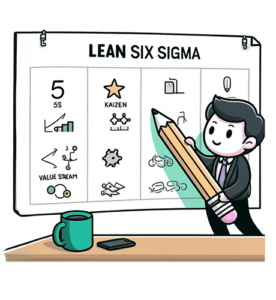Guide: Yellow Belt vs Green Belt
Compare Lean Six Sigma Yellow Belt and Green Belt certifications. Understand their roles, responsibilities, training, and benefits. Choose the right path for enhancing your process improvement skills.
Author: Daniel Croft
Daniel Croft is an experienced continuous improvement manager with a Lean Six Sigma Black Belt and a Bachelor's degree in Business Management. With more than ten years of experience applying his skills across various industries, Daniel specializes in optimizing processes and improving efficiency. His approach combines practical experience with a deep understanding of business fundamentals to drive meaningful change.
Lean Six Sigma is a methodology that combines Lean manufacturing principles and Six Sigma techniques to improve process efficiency and quality. Within this framework, there are different levels of certification, each denoted by a “belt” color. The two introductory levels are Yellow Belt and Green Belt. This guide will compare and contrast these two levels, outlining their roles, responsibilities, training requirements, and career benefits.
What is a Yellow Belt?
 A Yellow Belt in Lean Six Sigma is an entry-level certification designed to introduce individuals to the fundamental principles and methodologies of Lean Six Sigma. This certification serves as the first step in the Lean Six Sigma journey, providing foundational knowledge necessary for understanding and contributing to process improvement efforts within an organization.
A Yellow Belt in Lean Six Sigma is an entry-level certification designed to introduce individuals to the fundamental principles and methodologies of Lean Six Sigma. This certification serves as the first step in the Lean Six Sigma journey, providing foundational knowledge necessary for understanding and contributing to process improvement efforts within an organization.
Yellow Belts typically support more advanced Lean Six Sigma practitioners, such as Green Belts and Black Belts, by participating in projects and assisting with data collection and analysis. Their primary role is to comprehend the basics of process improvement and to apply these principles to enhance their everyday work activities. Yellow Belts play a crucial supportive role in larger Lean Six Sigma projects, ensuring that they understand how their specific tasks contribute to the overall improvement goals.
Responsibilities
 Understanding Basic Concepts: Yellow Belts must become familiar with Lean Six Sigma terminology, methodologies, and the overarching principles that drive process improvement. This foundational knowledge allows them to effectively communicate within a Lean Six Sigma project team and understand the importance of various improvement activities.
Understanding Basic Concepts: Yellow Belts must become familiar with Lean Six Sigma terminology, methodologies, and the overarching principles that drive process improvement. This foundational knowledge allows them to effectively communicate within a Lean Six Sigma project team and understand the importance of various improvement activities.Supporting Projects: One of the key responsibilities of Yellow Belts is to assist Green Belts and Black Belts with data collection and analysis. This involves gathering relevant data, performing preliminary analysis, and ensuring that data is accurate and reliable. By supporting these tasks, Yellow Belts enable more advanced practitioners to focus on strategic decision-making and complex analysis.
Participating in Improvement Teams: Yellow Belts actively participate in process improvement teams, contributing their knowledge and efforts to achieve project goals. They may be involved in brainstorming sessions, process mapping, and identifying areas for improvement. Their participation ensures that improvement efforts are well-rounded and inclusive of diverse perspectives.
Implementing Simple Improvements: Yellow Belts are equipped with basic Lean tools that they can apply to make small improvements in their work area. Tools such as 5S (Sort, Set in order, Shine, Standardize, Sustain) and Kaizen (continuous improvement) are often within the scope of a Yellow Belt’s capabilities. By implementing these simple improvements, Yellow Belts can have an immediate and positive impact on their work environment.
Training Requirements
Yellow Belt training is designed to be accessible and time-efficient, making it suitable for individuals new to Lean Six Sigma.
Duration: The training typically lasts between 1 to 3 days. This short duration is intentional, as it provides a concise yet comprehensive introduction to the key concepts and tools of Lean Six Sigma without requiring a significant time commitment.
Content: The content of Yellow Belt training covers:
- Introduction to Lean Six Sigma: Participants are introduced to the history, principles, and objectives of Lean Six Sigma. This section provides context and explains why Lean Six Sigma is important for organizations seeking process improvements.
- Basic Tools: Training includes an overview of basic Lean tools such as 5S and Kaizen, as well as simple statistical tools used for data analysis. These tools are essential for Yellow Belts to contribute effectively to improvement projects.
- Overview of DMAIC: The DMAIC (Define, Measure, Analyze, Improve, Control) methodology is a core component of Lean Six Sigma. Yellow Belt training provides an overview of each phase, highlighting the key activities and objectives. This ensures that Yellow Belts understand the structured approach used in Lean Six Sigma projects.
Overall, Yellow Belt certification serves as a valuable entry point for individuals looking to gain a foundational understanding of Lean Six Sigma. It equips them with the knowledge and skills necessary to support process improvement efforts, participate in project teams, and implement basic improvements in their work areas. As they progress in their Lean Six Sigma journey, Yellow Belts can build on this foundation to achieve higher levels of certification and take on more advanced roles within their organizations.
What is a Green Belt?
 A Green Belt in Lean Six Sigma is a professional who possesses an advanced understanding of Lean Six Sigma principles, tools, and methodologies. Green Belts play a critical role in process improvement within organizations by leading projects, applying complex problem-solving techniques, and driving changes that enhance efficiency and quality. They typically operate under the guidance of Black Belts but are also capable of managing smaller projects independently. This dual capability allows Green Belts to be both leaders and key contributors in Lean Six Sigma initiatives.
A Green Belt in Lean Six Sigma is a professional who possesses an advanced understanding of Lean Six Sigma principles, tools, and methodologies. Green Belts play a critical role in process improvement within organizations by leading projects, applying complex problem-solving techniques, and driving changes that enhance efficiency and quality. They typically operate under the guidance of Black Belts but are also capable of managing smaller projects independently. This dual capability allows Green Belts to be both leaders and key contributors in Lean Six Sigma initiatives.
Responsibilities
Leading Projects: Green Belts are responsible for managing Lean Six Sigma projects from inception to completion. This includes defining project scopes, setting objectives, developing project plans, and ensuring that goals are met within specified timelines. They lead cross-functional teams, coordinate activities, and communicate progress to stakeholders. By taking ownership of projects, Green Belts ensure that process improvements are implemented effectively and sustainably.
Problem-Solving: One of the core competencies of a Green Belt is the ability to use advanced problem-solving techniques. They employ tools such as root cause analysis, Fishbone diagrams, and Failure Mode and Effects Analysis (FMEA) to identify the underlying causes of process inefficiencies. By addressing these root causes, Green Belts can develop and implement solutions that yield significant improvements.
 Data Analysis: Green Belts are skilled in applying statistical analysis to evaluate process performance and identify opportunities for improvement. They use tools such as control charts, regression analysis, and hypothesis testing to analyze data and make data-driven decisions. This analytical approach helps in pinpointing variations, understanding trends, and validating the effectiveness of implemented solutions.
Data Analysis: Green Belts are skilled in applying statistical analysis to evaluate process performance and identify opportunities for improvement. They use tools such as control charts, regression analysis, and hypothesis testing to analyze data and make data-driven decisions. This analytical approach helps in pinpointing variations, understanding trends, and validating the effectiveness of implemented solutions.Training and Mentoring: Green Belts play an educational role within their organizations by training and mentoring Yellow Belts and other team members on Lean Six Sigma methodologies. They conduct workshops, provide guidance on using Lean Six Sigma tools, and foster a culture of continuous improvement. By sharing their knowledge, Green Belts help build organizational capability and ensure that Lean Six Sigma principles are consistently applied.
Implementing Improvements: Green Belts are directly involved in designing and implementing process improvements that lead to measurable results. They develop action plans, execute improvement strategies, and monitor the impact of changes. This hands-on approach ensures that improvements are not only theoretical but also practical and beneficial to the organization.
Training Requirements
Green Belt training is more comprehensive and in-depth compared to Yellow Belt training. It is designed to equip professionals with the knowledge and skills needed to lead Lean Six Sigma projects and drive significant improvements.
Duration: Green Belt training typically spans 2-4 weeks. This training can be completed in a continuous session or spread out over several months, allowing participants to balance training with their regular job responsibilities.
Content: The training content for Green Belts includes:
- In-Depth Study of DMAIC Methodology: Green Belts receive detailed training on the DMAIC (Define, Measure, Analyze, Improve, Control) methodology. Each phase of DMAIC is explored in depth, with practical examples and exercises to reinforce learning.
- Advanced Statistical Tools: Green Belt training covers advanced statistical tools used for data analysis. Participants learn how to use software tools such as Minitab or JMP for conducting sophisticated statistical analyses.
- Process Mapping: Training includes techniques for mapping processes, identifying bottlenecks, and analyzing workflows. Green Belts learn to create process maps, value stream maps, and other visual tools to understand and improve processes.
- Root Cause Analysis: Green Belts are trained in various root cause analysis techniques to identify the underlying causes of problems. This includes methods such as 5 Whys, Ishikawa (Fishbone) diagrams, and Pareto analysis.
- Project Management: Effective project management skills are crucial for Green Belts. Training covers project planning, team management, risk assessment, and communication strategies to ensure successful project execution.
By the end of their training, Green Belts are well-prepared to lead Lean Six Sigma projects, apply advanced analytical tools, and drive significant improvements within their organizations. They play a vital role in fostering a culture of continuous improvement and operational excellence.
Differences Between Yellow Belt and Green Belt
| Aspect | Yellow Belt | Green Belt |
|---|---|---|
| Role | Supportive role | Leadership role |
| Responsibilities | Assisting projects, basic improvements | Leading projects, data analysis, mentoring |
| Training Duration | 1-3 days | 2-4 weeks |
| Training Content | Basic concepts, simple tools | In-depth DMAIC, advanced tools |
| Project Involvement | Team member | Project leader |
| Expertise Level | Basic understanding | Advanced understanding |
Career Benefits
For Yellow Belts
- Introduction to Process Improvement: Gain a foundational understanding of Lean Six Sigma.
- Enhanced Job Performance: Apply basic tools to improve daily work processes.
- Career Advancement: Serve as a stepping stone to higher Lean Six Sigma certifications.
For Green Belts
- Leadership Skills: Develop project management and leadership abilities.
- Increased Value: Become a valuable asset to the organization by leading significant improvements.
- Career Opportunities: Open doors to higher-level positions and certifications (e.g., Black Belt).
Conclusion
Both Yellow Belt and Green Belt certifications are valuable in the Lean Six Sigma framework, each serving distinct roles within an organization. Yellow Belts support projects and learn the basics, while Green Belts lead projects and apply advanced techniques. Understanding the differences between these certifications can help individuals and organizations choose the right training and development path to achieve their process improvement goals.
References
- Ramu, G., 2016. The Certified Six Sigma Yellow Belt Handbook. Quality Press.
- Maathai, W., 2003. The Green Belt Movement: Sharing the approach and the experience. Lantern Books.
Q: What is the primary difference between Yellow Belt and Green Belt certifications?
A: The primary difference between Yellow Belt and Green Belt certifications lies in the level of responsibility and expertise. Yellow Belts have a foundational understanding of Lean Six Sigma principles and support project teams by assisting with data collection and basic analysis. Green Belts, on the other hand, are more advanced and take on leadership roles, managing projects, conducting detailed data analysis, and implementing process improvements.
Q: Who should pursue a Yellow Belt certification?
A: A Yellow Belt certification is ideal for individuals who are new to Lean Six Sigma and want to gain a basic understanding of its principles and tools. It is suitable for those who wish to support improvement projects and contribute to continuous improvement efforts without taking on leadership responsibilities.
Q: What are the career benefits of obtaining a Green Belt certification?
A: Obtaining a Green Belt certification offers several career benefits, including the development of strong leadership and project management skills, advanced knowledge of Lean Six Sigma tools and techniques, increased opportunities for higher-level positions, and the potential for higher salaries due to specialized skills and expertise.
Q: How long does it typically take to complete Yellow Belt and Green Belt training?
A: The duration of Yellow Belt training typically ranges from a few days to a week, depending on the program and the intensity of the coursework. Green Belt training is more comprehensive and can take several weeks to a few months to complete, as it covers in-depth methodologies, advanced statistical analysis, and project management skills.
Q: Can I advance from a Yellow Belt to a Green Belt certification?
A: Yes, you can advance from a Yellow Belt to a Green Belt certification. Many professionals start with a Yellow Belt to build a foundational understanding of Lean Six Sigma principles and then pursue a Green Belt to take on leadership roles and manage projects. Advancing from Yellow Belt to Green Belt involves more extensive training and a deeper understanding of Lean Six Sigma methodologies.
Author
Daniel Croft
Daniel Croft-Bednarski is a Continuous Improvement Manager with a passion for Lean Six Sigma and continuous improvement. With years of experience in developing operational excellence, Daniel specializes in simplifying complex concepts and engaging teams to drive impactful changes. He shares his expertise through LearnLeanSigma.com, offering tools, guides, and insights to help others implement Lean methods effectively. Daniel is committed to cultivating a culture of improvement, across the industry, through practical resources, innovative strategies, and a hands-on approach to leadership.
View Posts Free Lean Six Sigma Templates
Improve your Lean Six Sigma projects with our free templates.


